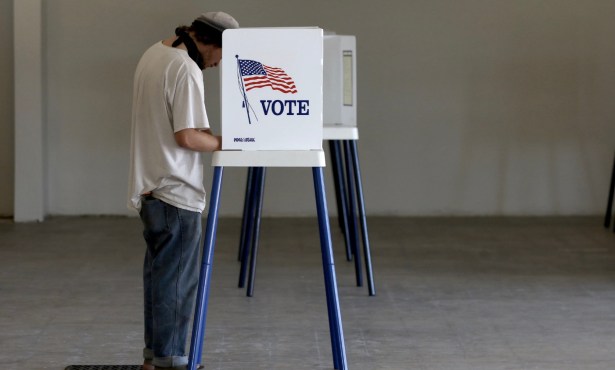Dog Eat Dog
Poodle Salivates at Prospect of Brokered Election
TRUMP THAT: I wish I could muster one-tenth the indignation as my friend Ernie Solomon, Santa Barbara’s undisputed king of curmudgeons. Ernie’s outraged because of the conspiracy hatched by the Powers-That-Be to deny Donald Trump the presidential nomination. Should Trump secure the popular vote among Republicans — he’s already won 100,000 more votes than Mitt Romney got four years ago — Establishment Big Wigs have vowed to use the delegate rules to block his nomination.

When you consider that Trump — the “Tangerine Tornado”— won every county in five eastern states this Tuesday, one can see Ernie’s point. But Party Big Wigs — freaking about Trump’s 75 percent negative approval ratings — insist they’re merely using the rules at everyone’s disposal.
I’m not out to bury Trump. Mostly I’m still trying to figure out if he’s the answer, what’s the question? Last week, the National Center for Health Statistics released some chilling stats that might shine a light. Suicides in the United States increased from 29,000 in 1999 to 43,000 last year. For those who failed math, that’s a 24 percent increase.* The fastest-growing cohort opting to pull their own ripcords was middle-aged women, 45-64 years old, done in by economic despair and divorce. Still, three times more men kill themselves than women.
In fact, more men killed themselves in 2014 — 33,113 — than all the suicides combined — 29,000 — reported in 1999. In 2014, white males — 27,000 — made up the vast majority. Middle-aged white males — for whom Trump’s angry outsider shtick so resonates — saw their suicide numbers double. To the extent experts are hazarding any guesses, the culprits are again economic hardship and family dissolution. None of these numbers include, by the way, the spike in overdose deaths from prescription opioids — from 4,000 to 18,000 — in the same time period.
But I digress. To my friend Ernie, I’d observe stolen presidential elections have become a dime a dozen. In my lifetime, it’s all but certain John Kennedy ripped off the 1960 election from Dick Nixon. Nixon, in turn, sabotaged the Paris Peace talks in 1968 — effectively extending the Vietnam War by 10,000 additional American deaths — to deep-six his Democratic rival Hubert Humphrey. Technically speaking, that was not so much theft as it was treason. Either way, it worked. In 2000, it’s indisputable Al Gore was ripped off and that the Supreme Court gave that election to George W. Bush.
As for myself, I’m looking forward to the suspenseful spectacle of a brokered Republican convention. Historians have scrambled to find precedent, and they’ve come up with the Democratic primary of 1924, one of the bloodiest acts of political suicide ever inflicted on a party by itself. It took no fewer than 103 ballots over 16 heat-baked days before John Davis, a nobody from West Virginia, won the nomination. The real fight, however, was between William G. McAdoo of California by way of New York and Georgia and Al Smith of New York. Fun factoid: McAdoo — a mover and shaker of genuine global dimension — lived in Santa Barbara with his wife, daughter of president Woodrow Wilson. At the time, he was also a business partner with T.M. Storke — owner of what would become the Santa Barbara News-Press — in various real estate development schemes.
Their relationship would blossom into one of the great political bromances of all time and with epic ramifications. If not for Storke and McAdoo, for example, Franklin D. Roosevelt would never have won his party’s nomination in 1932. And but for that — indirectly — there would be no UCSB and no Cachuma Reservoir, and Santa Barbara would be a very different place. But back in 1924, McAdoo had been endorsed by the Ku Klux Klan at a time when Congress had just passed what UCSB history professor Alice O’Connor described as “the most draconian, racially restrictive immigration legislation to date.” No, it wasn’t Trump’s “wall,” but close enough. In 1924, the Klan was huge — targeting not just blacks and Jews but Catholic “Papists,” too — like Al Smith. It strongly backed prohibition. McAdoo was as dry as Smith was wet. Somehow McAdoo, like Trump decades later, never saw fit to repudiate the Klan endorsement. In his book California Editor, Storke — a pro-McAdoo delegate — denied the Klan played any role in that convention. “If the Klan was at work I failed to see any evidence of it,” Storke wrote. “It was a phony issue from start to finish, fostered by the drunks who were supposed to be working for Smith’s nomination.” Maybe Storke didn’t see what he didn’t want to see. By most accounts, 20,000 Klansmen celebrated the 10th day of the convention — the Fourth of July — by congregating in New Jersey, where they burned crosses and effigies of Smith. On the convention floor, McAdoo supporters chanted, “Mac! Mac! McAdoo!” to which Smith’s supporters retorted, “Ku, Ku, McAdoo.”
Smith and McAdoo exhausted themselves trying — and failing — to secure the two-thirds majority needed, so eventually the 1924 convention — known now as “The Klanbake” — produced a nominee who had absolutely no chance, John Davis. That, Storke wrote, was by design, not by accident. Weeks before the convention, Storke wrote, he was informed by a Wall Street big shot that the fix was in for Davis because “the interests” knew he had no chance against Calvin Coolidge, the Republican nominee. However that “theft” rankled Storke, it didn’t stop him and McAdoo (in 1934) from spreading every lie imaginable as part of an exquisitely documented conspiracy by “the interests” to stop Upton Sinclair — then a socialist crusader who managed to snag the Democratic Party endorsement — from getting elected governor of California.
Sound familiar? We wuz robbed. But then, Ernie, we always have been.
* * *
* POODLE EATS CROW: When a newspaper writer gets slammed by readers, the customary face-saving response is to reply, “Thanks for reading me.” So let me say in advance, “Thanks for reading me.” In response to this week’s Poodle, many people have taken my math skills to task. I have received numerous emails pointing out that the spike in suicides from 1999 to 2014 — 29,199 to 42,773 — constitutes a 46 percent jump rather than the 24 percent I stated. Let me plead the most feeble defense imaginable: I merely quoted the numbers penned by the authors of the report, issued by the National Center for Health Statistics (NCHS). But I was not clear as to what it was that I was quoting. The fine print indicates that this number — 24 percent — refers to the rise in “the rate” of suicides, not the actual numbers. In addition, this figure is “age-adjusted,” another factor that changes the statistical spin. I have placed numerous calls and emails to the authors seeking explanation as to the disparity between the two measurements and will provide further elaboration as it trickles in. [The NCHS explains that the percentage quoted comes from removing the effects of population increase and aging, which it states is a standard way to measure mortality; 24 percent represents the difference between 10.5 suicides per 100,000 population in 1999 and 13.0 per 100,000 in 2014.] The real whopper of the column, however, was the assertion that opioid-related deaths had jumped from 4 million to 18 million in 15 years. In fact, the real numbers are 4,000 and 18,000. How that “million” got tagged onto these digits, I can only speculate about. UFO abduction? Chronic sleep depravity? Chem trails? Trance-channeling? No doubt, it was all of the above. The real answer is I seriously goofed. My apologies and thanks to the writers who brought this to my attention. And let me just add, “Thanks for reading.”



